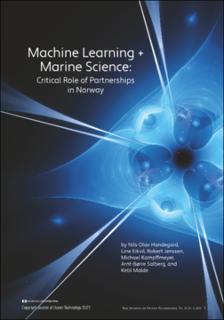| dc.contributor.author | Handegard, Nils Olav | |
| dc.contributor.author | Eikvil, Line | |
| dc.contributor.author | Jenssen, Robert | |
| dc.contributor.author | Kampffmeyer, Michael | |
| dc.contributor.author | Salberg, Arnt Børre | |
| dc.contributor.author | Malde, Ketil | |
| dc.date.accessioned | 2021-10-12T08:43:27Z | |
| dc.date.available | 2021-10-12T08:43:27Z | |
| dc.date.created | 2021-10-11T13:05:52Z | |
| dc.date.issued | 2021 | |
| dc.identifier.citation | Journal of Ocean Technology. 2021, 16 (3), . | |
| dc.identifier.issn | 1718-3200 | |
| dc.identifier.uri | https://hdl.handle.net/11250/2789224 | |
| dc.description.abstract | In this essay, we review some recent advances in developing machine learning (ML) methods for marine science applications in Norway. We focus mostly on deep learning (DL) methods and review the challenges we have faced in the process, including data preparation, (lack of) labelled training data, and interpretability. We also present the partnerships that have been formed between e-science institutions and marine science institutions in Norway. These partnerships have been instrumental in moving this effort forward and have been fuelled by grants from the Norwegian Research Council. The last addition to this collaboration is the recent centres for research-based innovation in Marine Acoustic Abundance Estimation and Backscatter Classification (CRIMAC) and Visual Intelligence (VI). | |
| dc.language.iso | eng | |
| dc.title | Machine Learning + Marine Science: Critical Role of Partnerships in Norway | |
| dc.type | Others | |
| dc.description.version | publishedVersion | |
| dc.source.pagenumber | 9 | |
| dc.source.volume | 16 | |
| dc.source.journal | Journal of Ocean Technology | |
| dc.source.issue | 3 | |
| dc.identifier.cristin | 1944898 | |
| dc.relation.project | Norges forskningsråd: 309512 | |
| cristin.ispublished | true | |
| cristin.fulltext | original | |
| cristin.qualitycode | 1 | |
